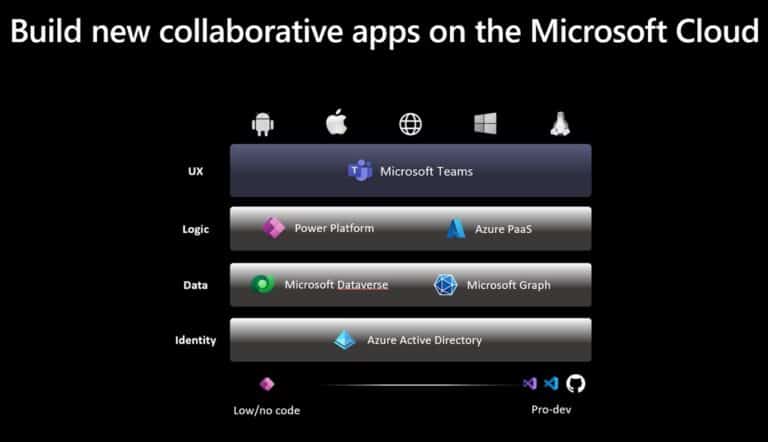Hybrid working has taken shape through COVID-19 and Microsoft sees opportunities to play a larger role in this with Microsoft Teams. Employees need to be able to work well together and, with 145 million daily users, Teams already plays a major role in this. With the announcements during Build, that role should increase even more. Microsoft will introduce various tools that will make it possible to develop apps on top of Teams, but also to share and use interactive elements (Fluid components) via Teams.
Microsoft has made several announcements during Build 2021. Including Microsoft Teams, which plays a major role in the Microsoft 365 strategy. Companies need a platform on which employees can collaborate, not just to communicate or work on documents or presentations together because that already works.
Microsoft is now adding the tools to develop applications or elements for use within Teams using Javascript. These can be internal applications, for instance, but also so-called Fluid components. These Fluid components can be edited in real-time or asynchronously by multiple co-authors. They work in both Teams and Office apps and on all platforms, Windows, macOS, Android and iOS. A Fluid component can be an interactive table, a list of items or a list of tasks. Things can be ticked off here, for example. These Fluid components can also be copied and pasted so that they are easy to reuse. The idea behind this is that fewer chat messages and meetings are needed.
At the moment, the Fluid components are still in a private preview, but they should become available later this year.
Building apps around meetings
Microsoft is also introducing more possibilities to build apps that are available during meetings. These apps can then be used interactively and collectively by participants in a meeting. Through the so-called shared stage integration, developers will get access to the main stage of a Teams Meeting. There are also new APIs available to automatically start workflows around a meeting, for example, when a meeting starts or ends. APIs will also become available to directly tap into the audio and video feed of a meeting. These feeds can be used to apply real-time subtitling or speech to text. This can help with the real-time translation of a speaker or for automated analysis of customer support calls through Teams.
Azure integration
With the improvement of the possibilities to build apps in and around Teams, Microsoft has also decided to offer more integrations with Azure, Azure Functions, Microsoft Graph and Sharepoint Framework. This allows apps to make use of data within Microsoft 365 and the infrastructure and services of Azure.
Partners can earn money with Team apps
The Microsoft Teams store will also have the possibility for in-app purchases and subscriptions. So that partners who build apps on top of the Teams platform will be able to earn money with it. Whether these companies will have to give up a part of their turnover to Microsoft is unclear at the moment. That there will be more opportunities for partners to earn money with apps is a good thing.
Microsoft Power Platform also brings low code to Teams
The rise of low code has been going on for several years now, and Microsoft has entered this market with its Power Platform. It has now announced that it will be easier to use low code tools in and for Teams. It will be easy to build and share apps with the Power Platform. It will also be easier to copy apps, bots, flows, tables or other elements from one Teams environment to another.
Teams must play a more central role in organisations
It has become clear that Microsoft is aiming to give Microsoft Teams a more central role in organisations. A place where people don’t just communicate, but where they can work together on projects through all kinds of integrations of apps within Microsoft Teams. These apps should reduce the amount of email and messages on Teams and increase productivity.
Recently, we already wrote that Google Workspace is on the same track. They are also working on the possibility of interactive elements within their Office products.
